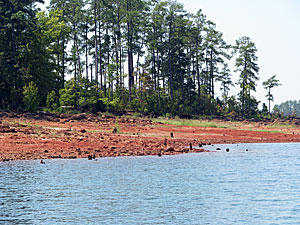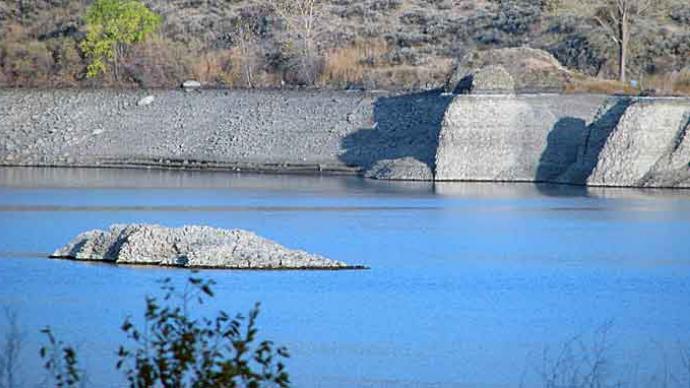
I hear a lot of people complaining about low water levels. I like to make the best of it. Exploring your favorite lake during low water periods will eliminate a lot of unproductive water and show you promising fishing areas you never knew existed.
My favorite time to fish is winter, but low water has to take second place. Of course, I'd hate to see low water during the spawn, but, for the most part, tournament season is over, and I'm now enjoying seeing my home lake from a different perspective. Although I've been fishing the Coosa for over twenty-five years, I still find things I didn't realize existed. For example, a shallow, tapering point that takes a sharp turn after going out thirty yards or so; or a point that appears to face one direction at full pool but turns at a ninety-degree angle after it hits the standard water line. I've found fields of standing timber that the tops have long ago fallen away from that seem to extend non-stop for a mile and have long-forgotten boat lanes cut through them.
In addition, there are lay downs whose stump ends can't be seen at full pool, along with humps, stumps, previously submerged vegetation, and other previously invisible structure and cover.
And, of course, there are the brush piles. I work hard setting out my brush piles during the winter, but I don't object to benefiting from another man's labor should the dropping water leave his exposed. One little twig sticking up may show you the location of a huge pile. This is also an excellent time to do a little pruning on your brush pile if you want to keep its location to yourself.
As I said, I like fishing in low water. I'm not talking about falling water, but where the water level has been lowered for a while. It doesn't take the fish long to get used to the change. I know not all lakes fish the same, but at least on Coosa, the fish that wanted to be shallow at normal levels still want to be shallow after the lake has dropped. However, they now have a lot less shoreline cover to choose from. Any timber or vegetation that extends into the water is prime real estate. Although shad don't require cover, minnows, and smaller bream do. Any small expanse of weeds or brush along the shoreline will likely be packed with them, and the bass are just as likely to be close by.
So, what is the best presentation to use when fishing for these bass? I can't say one technique works better than any other. If bass roam the shallows this time of year, it's for one reason - food. Buzz baits, trick worms, and swimming jigs work early for me, and then I'll back away and throw a rattle trap. Then, depending on the bite, I'll go to brush and lay downs or piers the rest of the day as the sun gets higher. The water level dropping just a few feet can eliminate a lot of piers. However, the piers in a creek still have some depth and can pay off with multiple fish.
If you decide to shy away from the lake during a drawdown, you will miss out on increasing your knowledge of the lake and may miss out on some really great fishing.
Steve Masters




